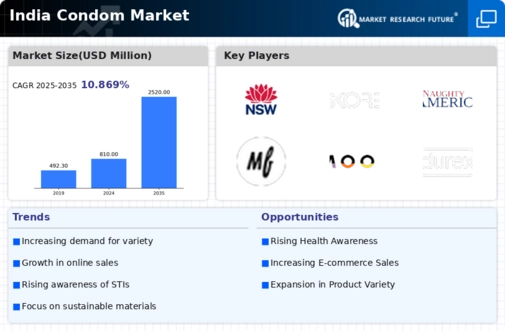Rising Health Consciousness
The increasing awareness of sexual health and reproductive rights among the Indian population appears to be a significant driver for the condom market. Educational initiatives and campaigns by both governmental and non-governmental organizations have contributed to a heightened understanding of sexually transmitted infections (STIs) and unintended pregnancies. This shift in perception is reflected in the growing demand for condoms, as individuals seek to protect their health. Recent data indicates that the market has seen a growth rate of approximately 15% annually, suggesting that more consumers are prioritizing safe sex practices. The condom market is likely to benefit from this trend, as health consciousness continues to rise, particularly among younger demographics who are more open to discussing and addressing sexual health issues.
Cultural Shifts Towards Acceptance
Cultural shifts in India regarding sexual health and contraception are gradually transforming societal attitudes towards condom usage. Traditionally, discussions around sex have been taboo, but recent trends suggest a growing acceptance of sexual health products. This change is particularly evident among urban youth, who are increasingly open to using condoms as a means of contraception and STI prevention. The condom market is likely to see a positive impact from this cultural evolution, as more individuals feel empowered to make informed choices about their sexual health. Market data indicates that the demand for condoms has surged by approximately 10% in urban areas, reflecting this shift in cultural norms and attitudes.
Government Initiatives and Policies
Government initiatives aimed at promoting safe sex practices and family planning are likely to play a crucial role in shaping the condom market. Programs that provide free or subsidized condoms, particularly in rural areas, have been instrumental in increasing accessibility. The National Health Mission in India has been actively involved in distributing condoms as part of its reproductive health strategy. This has resulted in a notable increase in condom usage, with reports indicating that the distribution of condoms has risen by over 20% in the last few years. Such policies not only enhance public health but also stimulate growth in the condom market, as they create a more favorable environment for condom consumption.
Influence of Social Media and Marketing
The influence of social media and targeted marketing strategies is becoming increasingly apparent in the condom market. Brands are leveraging digital platforms to engage with consumers, promote safe sex messages, and destigmatize condom usage. Creative marketing campaigns that resonate with younger audiences are likely to enhance brand visibility and consumer interest. Data shows that condom brands that actively engage on social media have experienced a sales increase of around 18%, suggesting that effective marketing can significantly impact consumer behavior. The condom market is poised to benefit from this trend, as brands continue to innovate their marketing approaches to reach a broader audience.
Technological Advancements in Product Development
Technological advancements in the production of condoms are contributing to the evolution of the condom market. Innovations such as ultra-thin materials and enhanced durability are appealing to consumers who prioritize both safety and pleasure. Manufacturers are increasingly investing in research and development to create products that cater to diverse consumer preferences. This focus on quality and innovation is likely to drive growth in the condom market, as consumers become more discerning in their choices. Recent market analysis suggests that the introduction of new product lines has led to a 12% increase in sales, indicating a strong consumer response to advancements in condom technology.



















Leave a Comment